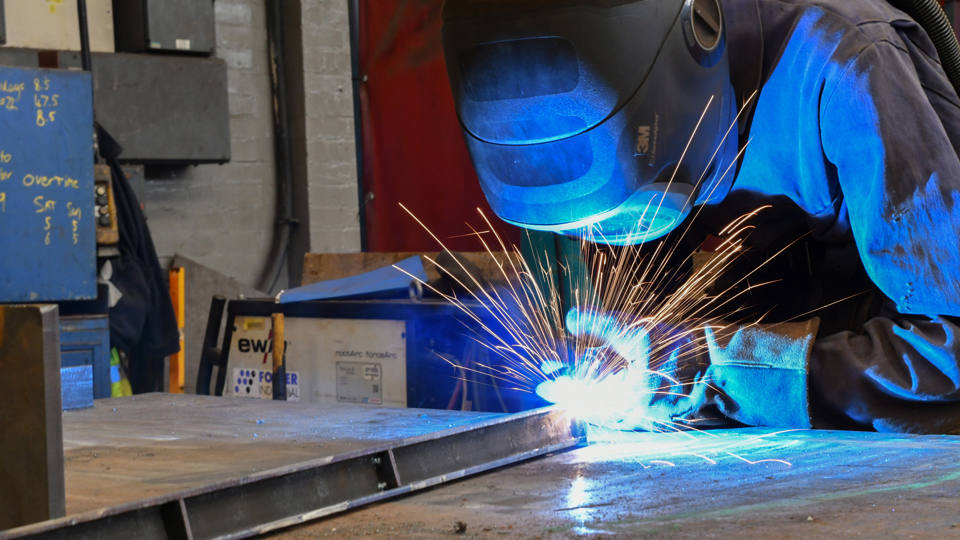Adey Steel – the case for a model of safety
A concept developed by IOSH was instrumental in a company’s decision to make positive changes to its health and safety culture.

“Improve our health and safety culture, focusing on behavioural safety”
That was the objective set for Charlotte Taylor, a new health and safety manager brought into the business at Adey Steel.
It was certainly a meaningful challenge, as records highlighted opportunities to strengthen consistency in following established processes and in the use of personal protective clothing. The aim was to solve technical issues and improve attitudes.
“I decided to do a benchmarking exercise and used the IOSH model of safety,” says Charlotte. “I felt it was a great clear framework. We could use it to identify where we are and what the culture needs to be to get to the level we want to be.”
The IOSH model of safety
This analytical tool helps company boards to understand their position on a scale of occupational safety and health (OSH) maturity. It demonstrates how OSH adds value to a business.
Using the model led Charlotte to draw the conclusion that “as a whole, it was evident we ‘tick the box’ in terms of compliance. We sat at a more embryonic or active level of OSH compliance (following the terminology of the model). We wanted to move towards a proactive and integrated level.”
This matched the company’s ambition to do more than merely follow rules and procedures. Among other things, it was concerned with prevention and wanted to differentiate between various kinds and levels of risk. This was, of course, admirable. But could it bring its workforce along with it?
Gauging staff opinion
Charlotte’s next steps to help with the benchmarking were to run a health and safety survey and hold consultations on the shop floor. There were some very revealing insights. One of the biggest stand-out areas was the attitude towards those who had responsibility for safety. “My favourite comment,” says Charlotte, “was in reference to challenging unsafe behaviour: ‘your job is health and safety manager. Therefore, you do it.’”
“We discussed this at board level. It was felt by all that that is not an effective way to manage safety. We decided we would move towards mainstreaming safety into all job roles. We would start with upskilling and training. This included IOSH courses, behavioural safety training and leadership training for all managers and those at supervisory levels.”
“The model of safety served as a great discussion point and it enabled us as senior leaders to discuss why and what needs to change. It also helped us form targets and objectives to achieve this.”
Charlotte Taylor
- Job role
- Group HSE/HR Manager
- Company
- Adey Steel
Following the benchmarking, Adey Steel commissioned a programme of company-wide health and safety training. This entailed an IOSH-approved course and some tailored training developed by Make UK (an approved IOSH training provider, with whom Adey already had an existing relationship).
As Charlotte and her colleagues recognised, “some of our leaders, whilst very good technically, needed some support. This was across many different levels. Previously we had focused on middle management by introducing things like IOSH’s Managing Safely® training for our production managers.”
Lee Hamilton, Environment, Health and Safety Delivery Manager at Make UK, recalled the collaboration with Adey Steel. “We provided interactive and engaging IOSH training to enhance the leadership team’s safety and health knowledge and reinforce a positive safety culture. The top-level commitment shown by the leadership team enabled us to deliver a bespoke designed behavioural safety programme to workshop and office staff.”
Motivations for investing in the training
The company was very measured in its decision to give substance to its ‘safety-first’ culture, which had been in place since 2014. “If we weren’t doing what we said we were, this ultimately could result in an accident or injury, operational downtime and insurance cost,” says Charlotte. “Undertaking the course meant that safety was embedded at board-level decision-making and that directors were aware of their personal liability.”
The company found that the work it was doing, such as focusing on senior leadership training, put it in a stronger position when tendering for jobs. “This was because it showed a commitment from top-down and ultimately helps meet client pre-qualification criteria, as well as readiness for external audits.”
How successful has the training been?
“The IOSH training, alongside our behavioural safety programme with Make UK, has led to a reduction in serious injuries. We saw a higher level of near-miss observation and recording than in previous years. It helped make safety personal and encouraged buy-in at all levels.
“We are still tracking improvements, as training and initiatives are ongoing. We have seen a greater awareness and are starting to see greater individual accountability towards safety.
“We have even changed our organisational structure to include key safety roles. For example, we have internal appointed persons and health and safety representatives, indicating a wider view on safety responsibility.”
Next steps
There is an air of optimism about the recent developments. Charlotte is very upbeat. “We hope to see this continue and see major accidents and incidents continue to reduce and root cause analysis show fewer personal behavioural causes. We also hope to see more engagement in health and safety initiatives.”
Adey, which marks its 100th anniversary this year, is very aware that health and safety competence needs to be kept up to date. To this end, there is a plan to repeat the health and safety survey. This is likely to be in spring 2026, two years after the original survey, to track changes. There is a strong hope of further safety improvements.
IOSH training can improve your business
Our courses support organisations to make positive changes to their health and safety culture
 IOSH
IOSH
